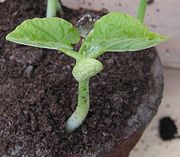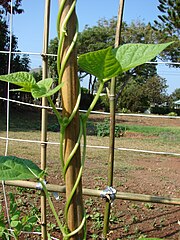Phaseolus vulgaris
| Phaseolus vulgaris | |
|---|---|
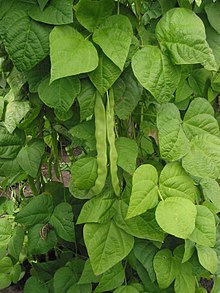
| |
A flat-podded variety of the common bean
| |
| Scientific classification | |
| Kingdom: | Plantae |
| Clade: | Tracheophytes |
| Clade: | Angiosperms |
| Clade: | Eudicots |
| Clade: | Rosids |
| Order: | Fabales |
| Family: | Fabaceae |
| Subfamily: | Faboideae |
| Genus: | Phaseolus |
| Species: | P. vulgaris
|
| Binomial name | |
| Phaseolus vulgaris | |
| Synonyms[2] | |
| |
Phaseolus vulgaris, the common bean,
The common bean has a long history of cultivation. All wild members of the species have a climbing habit,[4][5] but many cultivars are classified either as bush beans or climbing beans, depending on their style of growth. The other major types of commercially grown beans are the runner bean (Phaseolus coccineus) and the broad bean (Vicia faba).
Beans are grown on every continent except Antarctica. Worldwide in 2022, 28 million tonnes of dry common beans were produced, led by India with 23% of the total.[6]
Raw dry beans contain the toxic compound
Description
Bush varieties form erect bushes 20–60 centimetres (8–20 inches) tall, while pole or running varieties form
Like most species from Phaseolus, the genome of P. vulgaris has 11 chromosomal pairs (2n = 22). Its genome is one of the smallest in the legume family at 625 Mbp per haploid genome.[8]
Raw or undercooked beans contain a toxic protein called phytohaemagglutinin.[7]: 254
Taxonomy
The common bean, like all species of Phaseolus is a member of the legume family Fabaceae.
In Species Plantarum in 1753,
The beans cultivated in Europe prior to the
Etymology
P. vulgaris was known as ayacotl in the
History


1 – Mesoamerican area
2 – Andean area
The wild P. vulgaris is native to the Americas. It was originally believed that it had been domesticated separately in Mesoamerica and in the southern Andes region ~8000 years ago, giving the domesticated bean two gene pools.[15][16] However, recent genetic analyses show that it was domesticated in Mexico first, before the split into the Mesoamerican and Andean P. vulgaris gene pools.[17]
Beans,
The common bean arrived in Europe as part of the
Cultivation
Good commercial yield in favorable environments under irrigation is 6 to 8 ton/ha fresh and 1.5 to 2 ton/ha dry seed.[20]
Cultivars and varieties
Archeologists found large-seeded varieties of the domesticated bean in the highlands of Peru, dating to 2300 BC, and spreading to the coastal regions by around 500 BC.[21] Small-seeded varieties were found in sites in Mexico, dating to 300 BC, which then spread north and east of the Mississippi River by 1000 AD.[21]
Many well-known bean cultivars and varieties belong to this species, and the list below is in no way exhaustive. Both bush and running (pole) cultivars/varieties exist. The colors and shapes of pods and seeds vary over a wide range.
| Name | Image | Description |
|---|---|---|
| Anasazi | 
|
Anasazi beans are a dappled red and white bean first cultivated by Ancestral Puebloan people around 130 CE in what is now the Four Corners region of the United States. Anasazi Bean is often confused with Jacob's Cattle variety, but Anasazi has splashes of color, whereas Jacob's Cattle has splashes and small spots. Anasazi beans were adopted by commercial growers beginning in the 1980s and marketed under the name "Anasazi"; traditionally they were known by the Spanish names frijol conejo (rabbit bean), vaquita (little cow), or pájaro carpintero (woodpecker).[22][23] |
| Appaloosa | 
|
Front portion of the bean is ivory colored; the other end is speckled with reddish-purple and mocha. The bean is named after the Nez Perce tribe. The seed was cultivated near the Palouse River in Eastern Washington and Northern Idaho .
|
| Black turtle | 
|
The black turtle bean has small, shiny black seeds. It is especially popular in Latin American cuisine. |
| Bolita bean | 
|
Bolita beans are a traditional variety utilized in New Mexican cuisine by New Mexican Hispanos from northern New Mexico and southern Colorado. They can range from whitish-tan to beige, and even pinkish-purple in color. |
| Calypso | 
|
Calypso beans, also called Panda beans or Yin Yang beans, are half black and half white, with one or two black dots in the white area. When young, the pods can be harvested as a green bean. But when full-grown, they are used as a bean for drying. |
| Cranberry | The cranberry beans originated in Colombia as the cargamanto bean. Borlotti or Roman beans are a variety of cranberry bean bred in Italy to have a thicker skin. They are much used in Mediterranean cuisine. A widespread cultivar of European borlotti is 'Borlotto Lingua di Fuoco' (Tongue of Fire). | |
| Dragon tongue | 
|
Dragon tongue bean is a type of cranberry bean. It is a flavorful, juicy bean whose seeds are encased in a buffed, colorful pod with mottled burgundy patterns throughout the shell's surface. The shelled beans are pale pistachio green in color, their size, petite, and their shape, ovate and slightly curved.[24] |
| Flageolet | 
|
Flageolet beans are picked before full maturity and dried in the shade to retain a green color and a distinct taste. The seeds are small, light green, and kidney-shaped. The texture is firm yet creamy if shelled and cooked when fresh but semi-dry. They are often eaten in France, where they traditionally accompany lamb. |
| Kidney | 
|
Kidney beans, also known as red beans, are named for their visual resemblance in shape and color to kidneys. They are sometimes used in chili con carne and are an integral part of the cuisine in northern regions of India. They are also used in New Orleans and much of southern Louisiana for the Monday Creole dish of red beans and rice as well as the Caribbean habichuelas guisadas and Central American gallo pinto. |
| Jacob's Cattle | Similar to Anasazi in appearance, with the exception of having also dots. Legend says the Passamaquoddy indigenous people of Maine gave these beans as a gift to Joseph Clark, the first Caucasian child born in Lubec, Maine in the 1600s. Also known as Trout.[25] | |
| Mocha with Cherry | 
|
"Mocha with Cherry" is a polebean. This variety is said to come from the Rodope area in Bulgaria, and to be related to "Papa de Rola" and "Dove's Breast". |
| North Holland Brown | 
|
This bean is an old Dutch Heirloom bush variety primarily used for dried beans. |
| Pea, Painted Pony | A type of P. vulgaris called pea bean has been recorded in Britain since the 16th century. Vigna unguiculata subsp. sesquipedalis, also called yard-long bean and cowpea.[27] The seeds of the British pea bean are bicolored red-brown and white (not to be confused with Jacob's Cattle, which is more dark red than reddish-brown). The plants are typical climbing beans. The beans are either eaten in the pod-like French beans or may be harvested when mature and eaten as other dried beans.[28]
| |
| Peruano | 
|
Also known as mayocoba, canary, canario, Peruvian, Mexican yellow bean. A light green to jaundice yellow kidney-shaped bean that is preferred in certain regions of Mexico (such as Jalisco[29]) for making frijoles refritos, and for making tacu tacu, a pan-fried cake of leftover beans and rice.[30] Often described as having a "buttery" and "creamy" texture. |
| Pink | 
|
Pink beans are small, pale pink, oval-shaped beans also known by the Spanish name habichuelas rosadas. Santa Maria-style barbecue .
|
| Pinto | 
|
Pinto beans are named for their mottled skin (Spanish: pinto = painted or mottled). They are the most common bean in the United States[32] and northwestern Mexico,[33] and are most often eaten whole in broth or mashed and refried. Either whole or mashed, they are a common filling for burritos. The young pods may also be harvested and cooked as green pinto beans. |
| Polish Eagle Beans | 
|
Also called by the Independence bean by the Polish people because the brown pattern on the inner side of the bean resembles and Eagle - the Polish emblem. This bean variety was cultivated in XIX century as an act of patriotism by Polish people.[34] |
| Rattlesnake | A medium-sized, oblong bean with light brown seeds striped with brown markings. Named for the snake-like manner in which their pods coil around the vine.[35] | |
| Sulphur | aka China Yellow Bean: A thin-skinned, nearly round Maine heirloom bean that has a tawny yellow color but cooks white and has a distinctly unique flavor.[36] This is a choice variety for use in the traditional Bean Hole style.[37] | |
| Tiger's Eye | 
|
A bush variety, thought to have originated in Chile or Argentina.[38] |
| White | 
|
Navy beans or haricot beans are particularly popular in the United Kingdom and the United States. Other white beans include cannellini, a popular variety in central and southern Italy that is related to the kidney bean. White beans are the most abundant plant-based source of phosphatidylserine known.[39] |
| Yellow (Enola type) | 
|
'Sinaloa Azufrado,' 'Mayocoba,' and 'Peruano' (also called canary) are yellow beans. Peruano beans (see above) are small, oval, yellow beans about 1/2 in (1 cm) long with a thin skin. They have a creamy texture when cooked. Despite the name ('Peruvian beans' in Spanish), they are native to Mexico. Yellow beans are uncommon in the United States due to a controversial patent issued in 1999 to John Proctor, who selected and named a strain of yellow bean from seeds he brought back from Mexico. U.S. Patent No. 5,894,079 (the |
| Yellow Eye | 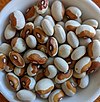
|
aka Maine Yellow Eye, this is the most popular baking bean in Maine, which comes in several strains, including the 'Steuben,' one of the oldest heirloom beans. It has a wide appeal for its clean, mild taste and is considered the baked bean of choice for church and grange suppers.[36] |
Production
| Country | Millions of tonnes |
|---|---|
| 6.6 | |
| 2.8 | |
| 2.7 | |
| 1.3 | |
| 1.2 | |
| 1.0 | |
| World | 28.3 |
| Source: FAOSTAT of the United Nations[6]
| |
In 2022, world production of dry common beans was 28 million tonnes, led by India with 23% of the total (table). Brazil and Myanmar were secondary producers.
Toxicity
The toxic compound phytohaemagglutinin, a lectin, is present in many common bean varieties but is especially concentrated in red kidney beans. White kidney beans contain about a third as many toxins as the red variety; broad beans (Vicia faba) contain 5 to 10% as much as red kidney beans.[7]
Phytohaemagglutinin can be inactivated by cooking beans for ten minutes at boiling point (100 °C, 212 °F). Insufficient cooking, such as in a slow cooker at 80 °C/ 176 °F, is insufficient to deactivate all toxins. To safely cook the beans, the U.S Food and Drug Administration recommends boiling for 30 minutes to ensure they reach a sufficient temperature for long enough to destroy the toxin completely.[42] For dry beans, the FDA also recommends an initial soak of at least 5 hours in water which should then be discarded.[7] Outbreaks of poisoning have been associated with cooking kidney beans in slow cookers.[7]
The primary
Beans are high in purines, which are metabolized to uric acid. Uric acid is not a toxin but may promote the development or exacerbation of gout. However, more recent research has questioned this association, finding that moderate intake of purine-rich foods is not associated with an increased risk of gout.[46]
Uses
Nutrition
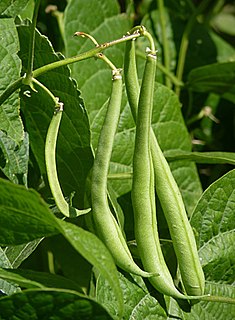 | |
| Nutritional value per 100 g (3.5 oz) | |
|---|---|
| Energy | 152 kJ (36 kcal) |
6.97 g | |
| Sugars | 3.26 g |
| Dietary fiber | 2.7 g |
0.22 g | |
1.3 g | |
Niacin (B3) | 5% 0.734 mg |
| Pantothenic acid (B5) | 5% 0.225 mg |
| Vitamin B6 | 8% 0.141 mg |
| Folate (B9) | 8% 33 μg |
| Vitamin C | 14% 12.2 mg |
| Vitamin E | 3% 0.41 mg |
| Vitamin K | 36% 43 μg |
Copper | 8% 0.069 mg |
| Iron | 6% 1.03 mg |
| Magnesium | 6% 25 mg |
| Manganese | 9% 0.216 mg |
| Phosphorus | 3% 38 mg |
| Potassium | 7% 211 mg |
| Selenium | 1% 0.6 μg |
| Sodium | 0% 6 mg |
| Zinc | 2% 0.24 mg |
| Other constituents | Quantity |
| Water | 90.3 g |
| †Percentages estimated using US recommendations for adults,[47] except for potassium, which is estimated based on expert recommendation from the National Academies.[48] | |
 | |
| Nutritional value per 100 g (3.5 oz) | |
|---|---|
| Energy | 581 kJ (139 kcal) |
25.1 g | |
| Sugars | 0.34 g |
| Dietary fiber | 6.3 g |
0.35 g | |
9.73 g | |
Niacin (B3) | 1% 0.14 mg |
| Pantothenic acid (B5) | 5% 0.229 mg |
| Vitamin B6 | 5% 0.093 mg |
| Folate (B9) | 20% 81 μg |
| Vitamin C | 0% 0 mg |
| Vitamin E | 6% 0.94 mg |
| Vitamin K | 3% 3.5 μg |
Copper | 32% 0.287 mg |
| Iron | 21% 3.7 mg |
| Magnesium | 15% 63 mg |
| Manganese | 28% 0.636 mg |
| Phosphorus | 9% 113 mg |
| Potassium | 19% 561 mg |
| Selenium | 2% 1.3 μg |
| Sodium | 0% 6 mg |
| Zinc | 13% 1.38 mg |
| Other constituents | Quantity |
| Water | 63.1 g |
| †Percentages estimated using US recommendations for adults,[47] except for potassium, which is estimated based on expert recommendation from the National Academies.[48] | |
Raw green beans are 90% water, 7%
Dry white common beans after boiling are 63% water, 25% carbohydrates, 10% protein, and contain little fat (table). In a reference amount of 100 grams (3.5 oz), boiled white common beans supply 139 calories and are a rich source of folate and manganese, with moderate amounts of thiamine and several dietary minerals (table).
Dry beans
Dry beans will keep indefinitely if stored in a cool, dry place, but as time passes, their
In Mexico, Central America, and South America, the traditional spice used with beans is
Dry beans may also be bought cooked and
Green beans and wax beans
The three commonly known types of green beans are string or snap beans, which may be round or have a flat pod; stringless or French beans, which lack a tough, fibrous string running along the length of the pod; and runner beans, which belong to a separate species, Phaseolus coccineus. Green beans may have a purple rather than green pod, which changes to green when cooked.[50] Wax beans are P. vulgaris beans that have a yellow[4] or white pod. Wax bean cultivars are commonly grown;[4] the plants are often of the bush or dwarf form.[4]
As the name implies, snap beans break easily when the pod is bent, giving off a distinct audible snap sound. The pods of snap beans (green, yellow and purple) are harvested when they are rapidly growing, fleshy, tender (not tough and stringy), and bright in color, and the seeds are small and underdeveloped (8 to 10 days after flowering).
Green beans and wax beans are often steamed, boiled, stir-fried, or baked in casseroles.
Shelling beans
Shell, shelled, or shelling beans are beans removed from their pods before being cooked or dried. Common beans can be used as shell beans, but the term also refers to other species of beans whose pods are not typically eaten, such as
Popping beans
The nuña is an Andean subspecies, P. v. subsp. nunas (formerly P. vulgaris Nuñas group), with round, multicolored seeds that resemble pigeon eggs. When cooked on high heat, the bean explodes, exposing the inner part in the manner of popcorn and other puffed grains.
Other uses
Bean leaves have been used to trap
From ancient times, beans were used as devices in various methods of divination. Fortune-telling using beans is called favomancy.
P. vulgaris has been found to bio-accumulate zinc, manganese, and iron and have some tolerance to their respective toxicities, suggesting suitability for natural bio-remediation of heavy-metal-contaminated soils.[52][non-primary source needed]
Gallery
-
Beans with smoked pork, a traditional Romanian dish
See also
- Adzuki bean
- Chickpea
- Dal
- Lentil
- List of dried foods
- List of diseases of the common bean
- Mung bean
- Organic beans
- Pressure cooking
- Vicia faba, or broad bean
References
- . Retrieved 11 November 2022.
- ^ "The Plant List: A Working List of All Plant Species".
- S2CID 29555157.,
- ^ ISBN 978-0-679-75024-6.[page needed]
- PMID 33173160.
- ^ FAOSTAT). 2024. Retrieved 20 February 2024.
- ^ a b c d e f g h "Bad Bug Book: Handbook of Foodborne Pathogenic Microorganisms and Natural Toxins: Phytohaemagglutinin" (PDF). United States Food and Drug Administration. Archived (PDF) from the original on 2013-04-18. Retrieved 2020-04-17.
- ISBN 978-0-12-227080-2.
- ^ Linnaei, Caroli (1753). Species plantarum : exhibentes plantas rite cognitas... (thanks to biodiversitylibrary.org) (in Latin). pp. 723–725. Retrieved 2023-11-18.
- ^ Chauvet, M. (1982). "Le point sur la nomenclature des haricots, à l'occasion de la parution de la monographie de Maréchal, Mascherpa et Stainie". Journal d'agriculture traditionnelle et de botanique appliquée (in French). 29 (1): 31–39.
- doi:10.1086/274456. Retrieved 2 December 2023.
p.328: Albertus Magnus, who lived in the thirteenth century, used the word faselus as denoting a specific plant, as "faba et faseolus et pisa et alia genera legurminis," "cicer, faba, faseolus."
- doi:10.1086/274456. Retrieved 2 December 2023.
p.328: He [Albertus Magnus] also says, " Et sunt faseoli multorum colorum, sed quodlibet granorum habet maculam nigramin loco cotyledonis."
- ^ Harper, D. (n.d.). "Etymology of bean". Online Etymology Dictionary. Retrieved 2 December 2023.
- .
- PMID 30308006.
- PMID 28356141.
- ^ Hill, Christina Gish (2020-11-20). "Returning the 'three sisters' – corn, beans, and squash – to Native American farms nourishes people, land and cultures". The Conversation. Retrieved 2021-01-08.
- ISBN 978-1-80046-496-4.
- ^ Food and Agriculture Organization of the United Nations (2023). "Bean". www.fao.org. Retrieved 2023-11-18.
- ^ ISBN 0-415-92746-3.
- ISBN 978-1-60774-434-4. Retrieved June 10, 2019.
- ^ Wood, Rebecca (May 2, 1993). "Oh, Beans! The Anasazi is 7,000 years old and still growing". Albuquerque Journal. Retrieved June 11, 2019 – via Newspapers.com.
- ^ "Dragon Tongue Shelling Beans". Specialty Produce. Retrieved 17 November 2023.
- ^ Slow Food USA. "Jacob's Cattle Bean". slowfoodusa.org/. Retrieved 17 April 2023.
Slow Food USA tends the Ark of Taste catalog, a repository of critically important but increasinglycritically important but increasingly endangered food sources.
- ^ "The Herball or Generall Historie of Plantes (1597)". mpg.de. p. 1040.
The party coloured kidney bean of Egypt Phaseolus aegypticus
- ^ "Vigna unguiculata subsp. sesquipedalis". Germplasm Resources Information Network. Agricultural Research Service, United States Department of Agriculture. Retrieved September 22, 2013.
- ^ – The National Vegetable Society – the Pea bean Archived January 25, 2007, at the Wayback Machine
- ISBN 978-0-8118-6069-7.
- ISBN 978-0-399-58149-6.
- ^ "Pink Bean – Definition and Cooking Information". RecipeTips.com. Retrieved 2012-01-14.
- ^ "Maize 2003 CGC Meeting". Ars-grin.gov. Archived from the original on 2012-09-15. Retrieved 2012-01-14.
- ^ [1] Archived April 10, 2005, at the Wayback Machine
- ^ Slurrp Editorial (Jan 7, 2023). "Uncovering The History Behind Poland's Iconic Eagle Bean: A Symbol Of Independence". Retrieved 16 November 2023.
- ISBN 978-1-4380-7621-8.
- ^ a b "A Taste of Maine". The University of Maine Folklife Center. Retrieved 2021-02-22.
- ^ "A Maine Tradition: Bean-Hole Beans". The University of Maine Folklife Center. Retrieved 2021-02-22.
- ^ Seed Savers Exchange. "Tiger's Eye Bean". seedsavers.org/. Retrieved 16 April 2023.
- ^ Souci SW, Fachmann E, Kraut H (2008). Food Composition and Nutrition Tables. Medpharm Scientific Publishers Stuttgart.
- ^ "The Enola Bean Patent Controversy: Biopiracy, Novelty And Fish-And-Chips". Law.duke.edu. Archived from the original on 2012-04-02. Retrieved 2012-01-14.
- ^ "Appeal 2007-3938" (PDF). Retrieved 2012-01-14.
- ^ "Bad Bug Book (2012)" (PDF). Foodborne Pathogenic Microorganisms and Natural Toxins Handbook: Phytohaemagglutinin. Food and Drug Administration. 2012. Retrieved 26 December 2013.
Consumers should boil the beans for at least 30 minutes to ensure that the product reaches sufficient temperature
- ^ "Be Careful With Red Kidney Beans in The Slow Cooker". Mother Earth News. 31 January 2013.
- ^ "Cooking safely with slow cookers and crock pots". foodsmart.govt.nz. Archived from the original on 2016-01-02. Retrieved 2014-01-06.
- ^ "Raw Kidney Beans". Home Food Preservation (Penn State Extension).
- S2CID 6478950.
- ^ a b United States Food and Drug Administration (2024). "Daily Value on the Nutrition and Supplement Facts Labels". Retrieved 2024-03-28.
- ^ )
- ISBN 0-684-81870-1, p. 271.
- ISBN 978-1-58574-473-2.[page needed]
- ^ PMID 23576783.
- S2CID 3482592.
External links
 Data related to Phaseolus vulgaris at Wikispecies
Data related to Phaseolus vulgaris at Wikispecies Food portal
Food portal Agriculture portal
Agriculture portal- Botany portal



